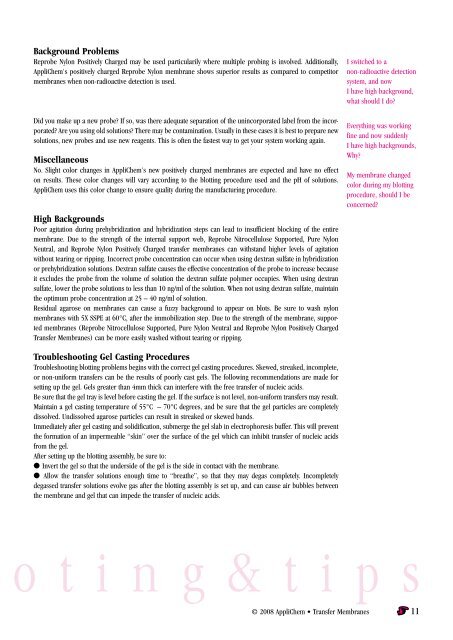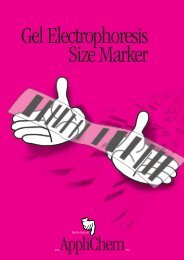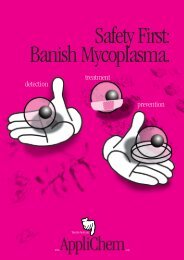Transfer Membranes
Transfer Membranes
Transfer Membranes
You also want an ePaper? Increase the reach of your titles
YUMPU automatically turns print PDFs into web optimized ePapers that Google loves.
Background Problems<br />
Reprobe Nylon Positively Charged may be used particularily where multiple probing is involved. Additionally,<br />
AppliChem's positively charged Reprobe Nylon membrane shows superior results as compared to competitor<br />
membranes when non-radioactive detection is used.<br />
Did you make up a new probe? If so, was there adequate separation of the unincorporated label from the incorporated?<br />
Are you using old solutions? There may be contamination. Usually in these cases it is best to prepare new<br />
solutions, new probes and use new reagents. This is often the fastest way to get your system working again.<br />
Miscellaneous<br />
No. Slight color changes in AppliChem's new positively charged membranes are expected and have no effect<br />
on results. These color changes will vary according to the blotting procedure used and the pH of solutions.<br />
AppliChem uses this color change to ensure quality during the manufacturing procedure.<br />
High Backgrounds<br />
Poor agitation during prehybridization and hybridization steps can lead to insufficient blocking of the entire<br />
membrane. Due to the strength of the internal support web, Reprobe Nitrocellulose Supported, Pure Nylon<br />
Neutral, and Reprobe Nylon Positively Charged transfer membranes can withstand higher levels of agitation<br />
without tearing or ripping. Incorrect probe concentration can occur when using dextran sulfate in hybridization<br />
or prehybridization solutions. Dextran sulfate causes the effective concentration of the probe to increase because<br />
it excludes the probe from the volume of solution the dextran sulfate polymer occupies. When using dextran<br />
sulfate, lower the probe solutions to less than 10 ng/ml of the solution. When not using dextran sulfate, maintain<br />
the optimum probe concentration at 25 – 40 ng/ml of solution.<br />
Residual agarose on membranes can cause a fuzzy background to appear on blots. Be sure to wash nylon<br />
membranes with 5X SSPE at 60°C, after the immobilization step. Due to the strength of the membrane, supported<br />
membranes (Reprobe Nitrocellulose Supported, Pure Nylon Neutral and Reprobe Nylon Positively Charged<br />
<strong>Transfer</strong> <strong>Membranes</strong>) can be more easily washed without tearing or ripping.<br />
I switched to a<br />
non-radioactive detection<br />
system, and now<br />
I have high background,<br />
what should I do?<br />
Everything was working<br />
fine and now suddenly<br />
I have high backgrounds,<br />
Why?<br />
My membrane changed<br />
color during my blotting<br />
procedure, should I be<br />
concerned?<br />
Troubleshooting Gel Casting Procedures<br />
Troubleshooting blotting problems begins with the correct gel casting procedures. Skewed, streaked, incomplete,<br />
or non-uniform transfers can be the results of poorly cast gels. The following recommendations are made for<br />
setting up the gel. Gels greater than 4mm thick can interfere with the free transfer of nucleic acids.<br />
Be sure that the gel tray is level before casting the gel. If the surface is not level, non-uniform transfers may result.<br />
Maintain a gel casting temperature of 55°C – 70°C degrees, and be sure that the gel particles are completely<br />
dissolved. Undissolved agarose particles can result in streaked or skewed bands.<br />
Immediately after gel casting and solidification, submerge the gel slab in electrophoresis buffer. This will prevent<br />
the formation of an impermeable “skin” over the surface of the gel which can inhibit transfer of nucleic acids<br />
from the gel.<br />
After setting up the blotting assembly, be sure to:<br />
● Invert the gel so that the underside of the gel is the side in contact with the membrane.<br />
● Allow the transfer solutions enough time to “breathe”, so that they may degas completely. Incompletely<br />
degassed transfer solutions evolve gas after the blotting assembly is set up, and can cause air bubbles between<br />
the membrane and gel that can impede the transfer of nucleic acids.<br />
o t i n g & t i p s<br />
© 2008 AppliChem • <strong>Transfer</strong> <strong>Membranes</strong> 11





